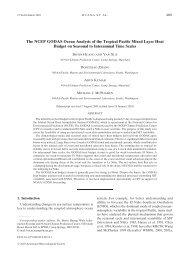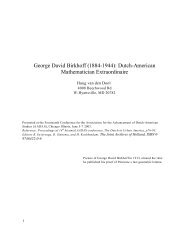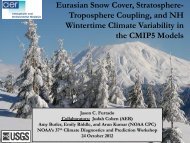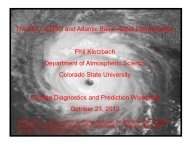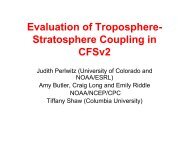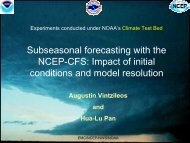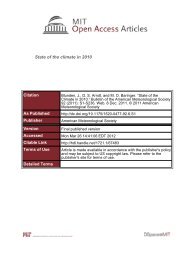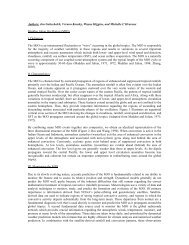Seasonality of the Pacific decadal oscillation - Climate Prediction ...
Seasonality of the Pacific decadal oscillation - Climate Prediction ...
Seasonality of the Pacific decadal oscillation - Climate Prediction ...
Create successful ePaper yourself
Turn your PDF publications into a flip-book with our unique Google optimized e-Paper software.
first EOF <strong>of</strong> <strong>the</strong> 1000-hPa zonal wind and <strong>the</strong> evolution <strong>of</strong> <strong>the</strong> MLD over <strong>the</strong> North<br />
<strong>Pacific</strong> domain. The surface zonal wind in <strong>the</strong> CFS displays strong seasonality with <strong>the</strong><br />
largest variability in February and March consistent with <strong>the</strong> large wind anomaly in <strong>the</strong>se<br />
two months (Fig. 6). The atmospheric forcing is thus strong in February and March and<br />
weak in summer. The variability <strong>of</strong> surface zonal wind in <strong>the</strong> observations exhibits quite<br />
similar seasonal variation. It is stronger than in <strong>the</strong> CFS during November through<br />
January and weaker during February through October, with a peak in February. The<br />
MLD in both <strong>the</strong> observation and CFS also shows a similar seasonality with <strong>the</strong> deepest<br />
depth in February or March and shallowest in summer.<br />
Variations in <strong>the</strong> surface wind forcing alone clearly cannot explain <strong>the</strong> peak <strong>of</strong> <strong>the</strong><br />
PDO variability in May and June. Since it is <strong>the</strong> mixed layer in <strong>the</strong> upper ocean that<br />
directly responds to <strong>the</strong> atmospheric forcing, <strong>the</strong> MLD is also expected to play an<br />
important role in determining <strong>the</strong> effectiveness <strong>of</strong> SST response to <strong>the</strong> atmospheric<br />
forcing. To illustrate this, Fig. 9c shows <strong>the</strong> seasonal variation <strong>of</strong> <strong>the</strong> square root <strong>of</strong> <strong>the</strong><br />
zonal wind variance divided by <strong>the</strong> MLD. The square root <strong>of</strong> <strong>the</strong> zonal wind variance<br />
denotes <strong>the</strong> amplitude <strong>of</strong> <strong>the</strong> zonal wind anomaly and thus <strong>the</strong> amplitude <strong>of</strong> atmospheric<br />
forcing. As divided by <strong>the</strong> MLD, <strong>the</strong> value is approximately proportional to <strong>the</strong> forcing<br />
per unit mass for <strong>the</strong> mixed layer over which <strong>the</strong> influence <strong>of</strong> atmospheric forcing gets<br />
distributed and affects <strong>the</strong> SST anomaly. Given that it takes about one month for <strong>the</strong> SST<br />
to respond to <strong>the</strong> atmospheric forcing, <strong>the</strong> values plotted in Fig. 9c for month N are<br />
obtained by using <strong>the</strong> MLD in month N and <strong>the</strong> zonal wind variance in previous month<br />
N–1. The rate <strong>of</strong> <strong>the</strong> zonal wind variance square root to <strong>the</strong> MLD in <strong>the</strong> CFS peaks in<br />
June as <strong>the</strong> PDO variability in Fig. 1d. This implies that <strong>the</strong> 1-month time scale for <strong>the</strong><br />
13




